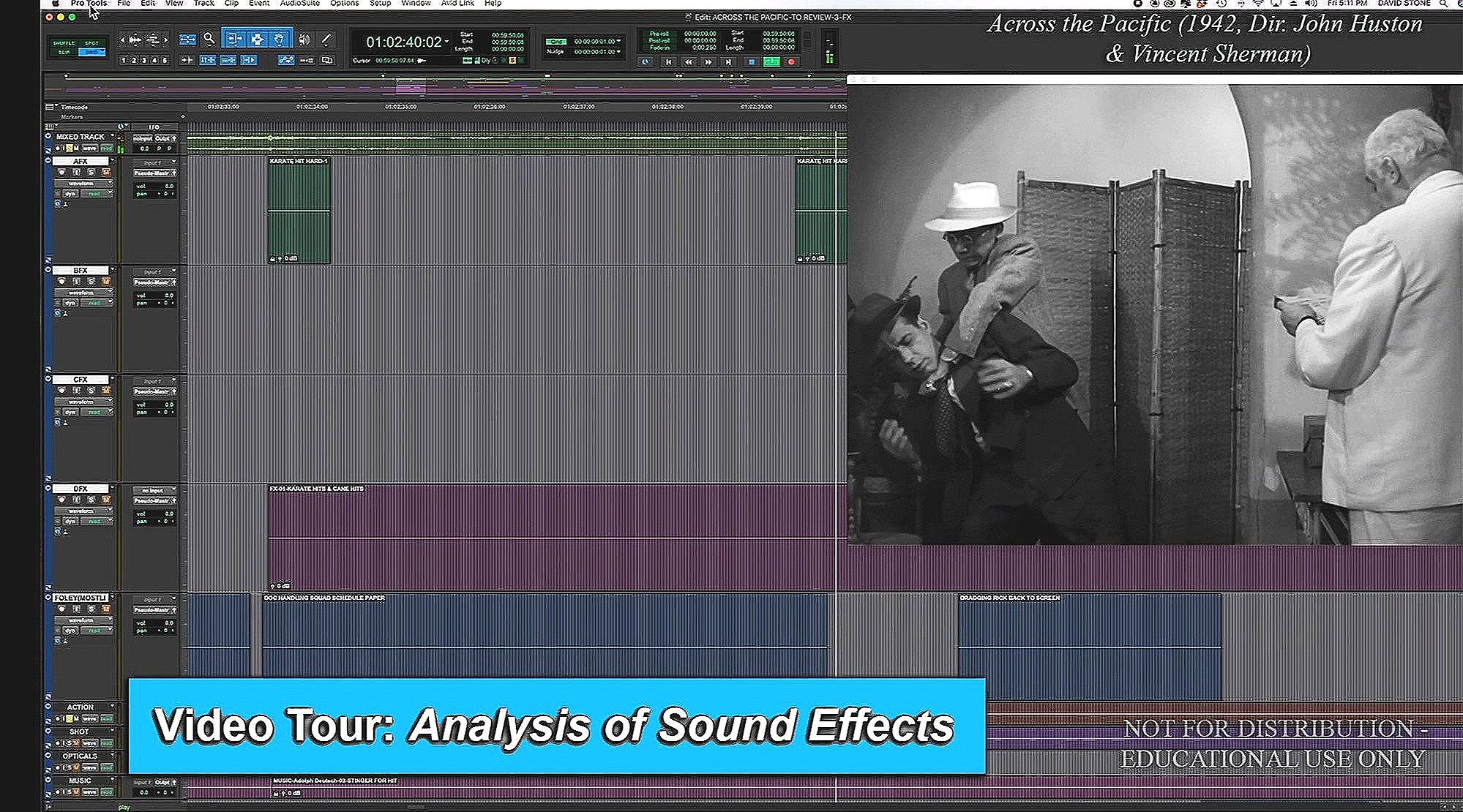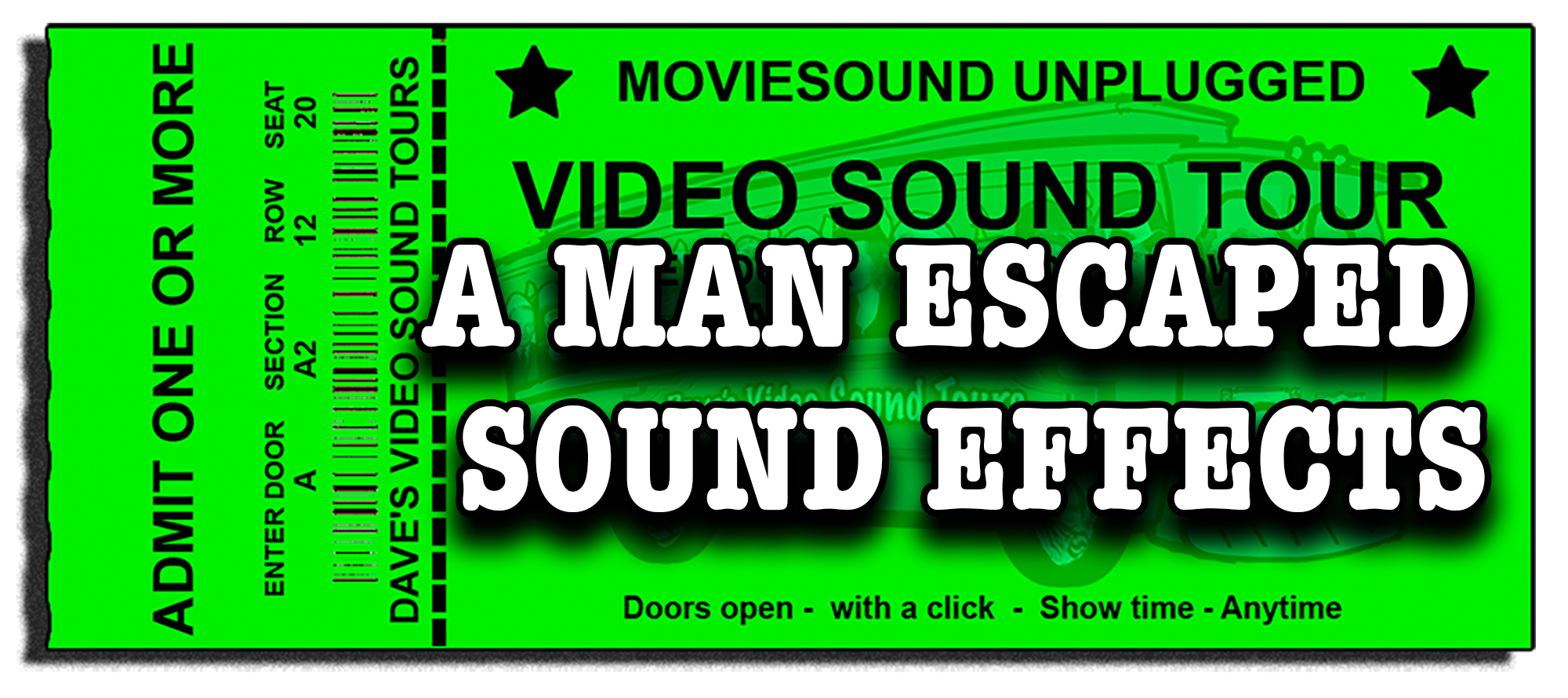
These Video Sound Tours run about 5 to 10 minutes. You’ll want to view the plain CLIP first, to see if you’re interested in the movie, before setting off on your sound tours.

The film clips will show different “Food Groups” of sound craftsmanship rolling in a Pro Tools interface, against the action. Pick a movie to begin, and try to watch all the Tours, starting with the CLIP
YOU CAN OPEN OR CLOSE AUTO-GENERATED
CLOSED CAPTIONS ON THE
LOWER RIGHT CORNER OF THE VIDEO

THERE’S A TAB BELOW FOR EACH OF THE 12 FILM TITLES,
AND THE TABS CONTINUE TO THE RIGHT—>
The Video Sound Tours represent our close analysis of selected clips from old movies.
All are mixed down by staff studio re-recording mixers from a handful of monaural sound track elements, to a single track for release to the theaters.
An excellent video doc, Passion, Sound and Fury was released with a re-issue of King Kong (1933) on DVD. It celebrates the music of Max Steiner and the creativity of Murray Spivak, who we consider the Founding Father of movie Sound Design.
In that early period, directors were not on the mixing stage to influence those choices. Usually, studio directors were off on another job when the film was mixed, and there would be a producer on the stage, getting it done efficiently. By contrast, the 21st Century movie director is almost always attending the mix, and sometimes leading the re-recording team in a less-than-efficient way.
I tried to enhance his (Max Steiner’s) music by not having the sound effects interfere with the music. And very often, I’d pitch the sound effects the least bit higher or the least bit lower so that it was at least in harmony with the music.
– Murray Spivak
They had to be very selective in their dubbing of the film: How many sounds could you hear at once? And there were limits that just probably forced them to some extent to make very definite creative decisions.
– Ben Burtt (senior Sound Designer for Lucasfilm)

Some of the Video Sound Tours are presented as ProTools audio editing sessions, but with separate graphic tracks of notation, rather than tracks of real audio.
The sound was already mixed, and we can separate these parts only by critical listening. It’s our movie sound version of Art History analysis. We attempt to delineate, for instance, Sound Effects moments, so you can watch them flow by along with the edited picture, and the other (notation) tracks of the different kinds of sounds. The idea is to try to visualize at once the collage of simple sound elements as well as the moving image and the mixed sound of the clips. Try to observe how different kinds of sound work can overlap at the heads and tails of any shot, how they are independent of the picture cuts. Notice the creativity of directors, film editors, or assistant film editors in making these decisions. That is the most primitive foundational version of what we call today sound design.
Here is an example of the power of these kinds of decisions:
In our analysis of Act of Violence (1948, Dir. Fred Zinnemann) we discovered an outstanding choice to withhold any music during the critical climax. Frank (Van Heflin) has a long, slow walk at night outside a train station, leading up to a confrontation with Joe (Robert Ryan) that will certainly end in death. We hear only Frank’s footsteps, Joe’s limping footsteps, and wind. The entire confrontation has no music at all, for a full four minutes and fifteen seconds, even when the action becomes loudly busy and violent with a car racing away. Music never imposed itself on the action. Consequently, the final music cue, leading from the tragic end of action into the end titles serves as an emotional denouement to the story.
BARS AND YIPES!
(F.A.Q. ABOUT THE COLOR BARS AND THE TEST TONE)

ANYONE FAMILIAR WITH THE BROADCASTING BUSINESS OR WITH PROFESSIONAL SOUND EDITING AND MIXING IN THE LATE 20th AND EARLY 21st CENTURIES WILL RECOGNIZE THE STANDARD INDUSTRIAL “BARS AND TONE” AT THE HEAD END OF MOST OF OUR VIDEO TOURS. THE STANDARD COLOR BARS WERE NECESSARY FOR WORKERS TO TRACE A MSSING VIDEO INPUT OR CALIBRATE THEIR MONITORS, AND THE 1-KiloHerz AUDIO TONE HAS BEEN USED ON THE AUDIO SIDE OF MEDIA EVER SINCE THE EXTINCTION OF THE PTERODACTYL.
COULD THE ANNOYING AND UBIQUITOUS 1-KiloHerz AUDIO TONE HAVE BEEN THE EXACT SOUND THAT WAS USED TO LEVITATE THE MYSTERIOUS MEGALITHS OF EASTER ISLAND AND STONEHENGE? ANCIENT ALIEN THEORISTS SAY “NO. IT’S JUST TO LINE UP OUR EQUIPMENT.” THAT’S A FACT OF MEDIA NERD LIFE. DEAL WITH IT!













































































